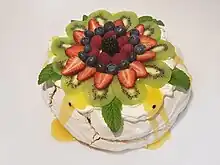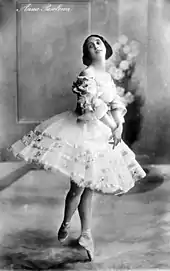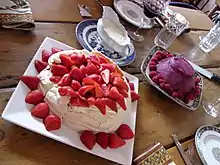Pavlova (dessert)
Pavlova is a meringue-based dessert. Originating in either Australia or New Zealand in the early 20th century, it was named after the Russian ballerina Anna Pavlova.[1] Taking the form of a cake-like circular block of baked meringue, pavlova has a crisp crust and soft, light inside. The confection is usually topped with fruit and whipped cream.[2] The name is commonly pronounced /pævˈloʊvə/ pav-LOH-və or (in North America) /pɑːvˈloʊvə/ pahv-LOH-və, and occasionally closer to the name of the dancer, as /ˈpɑːvləvə/ PAHV-lə-və.[3][4][5]
 A pavlova garnished with whipped cream, passionfruit and lemon sauce, mint leaves, kiwifruit, strawberries, blueberries, raspberries and a boysenberry. | |
| Course | Dessert |
|---|---|
| Associated cuisine | Australia, New Zealand |
| Main ingredients | Egg whites, caster sugar, fruit |
The dessert is believed to have been created in honour of the dancer either during or after one of her tours to Australia and New Zealand in the 1920s.[2] The nationality of its creator has been a source of argument between the two nations for many years.[6]
The dessert is an important part of the national cuisine of both Australia and New Zealand. With its simple recipe, it is frequently served during celebratory and holiday meals. It is most identified with and consumed most frequently in the summer time, including at Christmas time.[2]
Origin

The early history of pavlova can be traced to Australia, where recipes for a very similar dish have been found dating back to 1906, though this dish was only called a 'cream cake' and did not yet bear the name 'pavlova'.[7]
A recipe for "Strawberries Pavlova" appeared in the New Zealand Herald on 11 November 1911, but this was a kind of ice block or sorbet.[8]
A 1922 book Australian home cookery by Emily Futter contained a recipe for "Meringue with Fruit Filling".[9] This is the first known recipe for a food entirely resembling the modern pavlova, though not yet known by that name.[9]
The first known recipe for a dish bearing the name 'Pavlova' is from Australia in 1926 published by the Davis Gelatine company in Sydney.[10][11] However, it was a multi-layered jelly, and not the meringue, cream and fruit dessert known today.[11][2]
Helen Leach, in her role as a culinary anthropologist at the University of Otago, states that the first recipe from New Zealand was a recipe for 'pavlova cake' in 1929.[2][12] A recipe for pavlova cake was published in The Evening Star on 10 November 1934.[13]
It has also been claimed that Bert Sachse created the dish at the Esplanade Hotel in Perth, Western Australia, in 1935.[14][15] In defence of his claim as inventor of the dish, a relative of Sachse's wrote to Leach suggesting that Sachse may have accidentally dated the recipe incorrectly. Leach replied they would not find evidence for that "because it's just not showing up in the cookbooks until really the 1940s in Australia." However, a recipe for "pavlova cake" was published in The Advocate in 1935,[16] and a 1937 issue of The Australian Women's Weekly contains a "pavlova sweet cake" recipe.[17] A 1935 advertisement for a chromium ring used to prevent the dessert collapsing also indicates that the term "pavlova cake" had some currency in Auckland at that time.[18]
Other researchers have said that the origins of pavlova lie outside both Australia and New Zealand. Research conducted by New Zealander Andrew Paul Wood and Australian Annabelle Utrecht found that the origins of the modern pavlova can be traced back to the Austro-Hungarian Spanische windtorte. It was later brought to the United States where German-speaking immigrants introduced meringue, whipped cream, and fruit desserts called schaum torte ("foam cake") and baiser torte. American corn starch packages which included recipes for meringue were exported to New Zealand in the 1890s.[19]
An article in Melbourne's The Argus from 17 November 1928 claims an "American ice-cream" was named after Anna Pavlova: "Dame Nellie Melba, of course, has found fame apart from her art in the famous sweet composed of peaches and cream, while Mme. Anna Pavlova lends her name to a popular variety of American ice-cream."[20] This article may suggest that pavlova has American origins. However, it's unclear how these words should be interpreted and whether that article is relevant. Firstly, the authors of that article offer no evidence for their claims or any depth of discussion of their claims. Secondly, given that pavlova is not an ice-cream, it is highly unclear as to whether the words "American ice-cream" is referring to the modern pavlova dessert or something else entirely.[20]
Michael Symons, an Australian then researching in New Zealand, has declared that pavlova has no singular birthplace. Rather, published recipes reveal the complex process of "social invention" with practical experience circulating, under a variety of names, across both countries. For example, Australians beat New Zealanders to create an accepted pavlova recipe as the 'Meringue Cake'. The illusion of some singular invention can be explained by distinguishing a second, associated level of "social construction", in which cooks, eaters and writers attach a name and myths to produce a widely-held concept that appears so deceptively distinct that it must have had a definite moment of creation.[21]
Matthew Evans, a restaurant critic for The Sydney Morning Herald, said that it was unlikely that a definitive answer about the dessert's origins would ever be found. "People have been doing meringue with cream for a long time, I don't think Australia or New Zealand were the first to think of doing that."[22]
Preparation and consumption

Pavlova is made in a similar way to meringue. Egg whites (and sometimes salt) are beaten to a very stiff consistency, gradually adding caster sugar before folding in vinegar or lemon juice (or another edible acid), cornflour, and vanilla essence. The meringue mixture is placed on to baking paper and shaped to form a round cake around 20 cm (8 in) in diameter with a slightly recessed centre. The meringue is baked in a slow oven (120–150 °C; 250–300 °F) for 45–60 minutes, then left in the oven to cool and dry out, usually overnight.[23][24]
Pavlova has a crisp and crunchy outer shell, and a soft, moist marshmallow-like centre, in contrast to meringue which is usually solid throughout. It has been suggested the addition of cornflour is responsible for the marshmallow centre, although it has been debated that the cornflour is just another egg white stabiliser in addition to the acid.[25]
Pavlova is traditionally decorated with a topping of whipped cream and fresh soft fruit such as kiwifruit, passionfruit, and strawberries.[26] Factory-made pavlovas can be purchased at supermarkets and decorated as desired. A commercial product is available that includes pre-mixed ingredients for baking the meringue shell, requiring only the addition of water and sugar.
Leftover decorated pavlova can be refrigerated overnight, but the dessert will absorb moisture and lose its crispness.[27] Undecorated pavlova can be left overnight in the oven, or for several days in an airtight container, to be decorated when ready.
In culture

Pavlova is popular on Christmas Day as a dessert usually served after being refrigerated due to Christmas being celebrated during the summer in the southern hemisphere.[2]
World's largest pavlova
Te Papa, New Zealand's national museum in Wellington, celebrated its first birthday in February 1999 with the creation of purportedly the world's largest pavlova, dubbed Pavzilla, which was cut by Prime Minister Jenny Shipley.[28] This record was broken by students at the Eastern Institute of Technology in Hawke's Bay, New Zealand, in March 2005. Their creation, Pavkong, stretched 64 metres long in comparison to Te Papa's 45-metre-long pavlova.[29] In August 2010, chef Aaron Campbell displayed a 50-square-metre rugby-themed pavlova, with the Bledisloe Cup in the centre, in the ChristChurch Cathedral in Christchurch, to raise money for the official charity of the All Blacks.[30] In May 2018 a Norwegian chef and 35 assistants produced an 85-square-metre pavlova.[31]
See also
References
- Boylen, Jeremy (reporter) (20 August 2004). Pavlova George Negus Tonight, Australian Broadcasting Corporation. Archived
- Leach, Helen (2008). The Pavlova Story: A Slice of New Zealand's Culinary History. Otago University Press. pp. 11–31. ISBN 978-1-877372-57-5.
- Macquarie Dictionary, Fourth Edition (2005). Melbourne, The Macquarie Library Pty Ltd. ISBN 1-876429-14-3
- Orsman, H.W. (ed.) (1979) Heinemann New Zealand dictionary. Auckland: Heinemann Educational Books (NZ)
- Dictionary.com, "pavlova", in Dictionary.com Unabridged (v 1.1). Source location: Random House, Inc. http://dictionary.reference.com/browse/pavlova. Available: http://dictionary.reference.com. Accessed: 26 April 2009.
- Wilson, John. "Pavlova rivalry". Te Ara: The Encyclopedia of New Zealand. Retrieved 7 May 2020.
- "Cream Cake". Trove. The Queenslander. 10 February 1906. Retrieved 25 November 2019.
- "The Home. The Strawberry Season". The New Zealand Herald via Papers Past. 11 November 1911.
- Symons, Michael (15 April 2010). "The confection of a nation the social invention and social construction of the Pavlova". Social Semiotics. 20 (2): 202. doi:10.1080/10350330903566004. S2CID 144496353. Retrieved 25 November 2019.
- Leach, Helen (Spring 2010). "The Pavlova Wars: How a Creationist Model of Recipe Origins Led to an International Dispute". Gastronomica. 10 (2): 26. doi:10.1525/gfc.2010.10.2.24.
- "Pavlova Doco".
- Park, Nicky (3 December 2010). "Dictionary sides with NZ in pavlova debate". Sydney Morning Herald. Retrieved 26 November 2019.
- "The Right Recipe. Some request cake recipes". The Evening Star via Papers Past. 10 November 1934. p. 24.
- See, for example, M. Symons (1982) One continuous picnic: a history of eating in Australia. Adelaide: Duck Press.
- "The Man Who Created The Pavlova". The Beverley Times. Vol. 69, no. 4. Western Australia. 14 February 1974. p. 4. Retrieved 18 September 2021 – via National Library of Australia.
- "An Elaborate Cake". The Advocate, republished by Trove, National Library of Australia. 14 September 1935.
- "These are... OUT of the BOX!". The Australian Women's Weekly. Australia: National Library of Australia. 10 July 1937. p. 39 Supplement: 16 Pages of Cookery. Retrieved 6 January 2011.
- "Milne & Choyce". Auckland Star. via Papers Past. 5 September 1935. p. 21.
- "Pavlova research reveals dessert's shock origins". Good Food. 10 October 2015. Retrieved 8 October 2019.
- "IN THE PAPERS". The Argus. Melbourne: National Library of Australia. 17 November 1928. p. 5 Supplement: The Argus. Saturday Camera Supplement. Retrieved 8 October 2019.
- "The confection of a nation: The social invention and social construction of the Pavlova". Academia.edu. 15 April 2010. Retrieved 8 October 2019.
- "Antipodean palaver over pavlova". BBC News. 19 July 2005. Retrieved 17 July 2009.
- "Traditional Pavlova Recipe". foodtolove.com.au. Retrieved 18 May 2016.
- "Pavlova". edmondscooking.co.nz. Archived from the original on 9 November 2021. Retrieved 23 March 2021.
- "How to Make Perfect Pavlova and Meringues". Foodlovers.co.nz. Retrieved 11 July 2014.
- "Contains Pavlova Toppings". InMamasKitchen.com. Archived from the original on 5 December 2010. Retrieved 16 November 2010.
- Lawson, Nigella (3 October 2014). "Refidgerated Chocolate Raspberry Pavlova". www.nigella.com. Retrieved 7 May 2020.
- Armstrong, Dave (8 January 2018). "Sotheran's lasting national legacy". The Dominion Post. Retrieved 7 May 2020.
- "Students make world's biggest Pavlova". The New Zealand Herald. 21 March 2005. Retrieved 7 May 2020.
- "Charitable Kiwi chef whips up giant pavlova". NewZealand.com. Tourism New Zealand. 6 August 2010. Retrieved 16 November 2010.
- "Norwegians smash Kiwi pavlova world record". The New Zealand Herald. 16 May 2018. Retrieved 3 July 2021.
Further reading
- Leach, Helen M. (1997). "The pavlova cake: the evolution of a national dish". In Walker, Harlan (ed.). Food on the Move: Proceedings of the Oxford Symposium on Food and Cookery, 1996. Devon, England: Prospect Books. pp. 219–223. ISBN 0-907325-79-3.